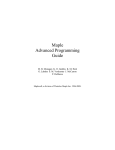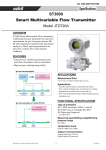Download Lesson Five. Calculus - Department of Mathematics
Transcript
Lesson Five. Calculus
L. Valdes
Department of Mathematics
San Jose State University
Objectives: To be able to
1.
2.
3.
4.
5.
find limits of functions
find derivatives of functions
find partial derivatives and derivatives of higher order
integrate functions
find the Taylor polynomial approximations of functions
Read Section 4.4 in User Manual
To begin this lesson let us define some functions so they will be at the ready. Say
1
f x = 3 x2 C19 x K14, g x = sin x Ccos 3 x and h x =
C2. We will also need some
x
3xy
x
multivariable functions. Type in f1 x, y = 2
and g1 x, y = sin
.
2
y
x Cy
There is also a package called student that we will be working with so let us open it now. Remember
how? with(student);
f := x/3 x2 C19 x K14
g := x/sin x Ccos 3 x
1
h := x/ C2
x
3xy
f1 := x, y / 2
x Cy2
x
g1 := x, y /sin
y
(1)
Limits
To find the limit of a function we write limit(function,x=a,direction) where direction is right or left.
If direction is omitted, then the limit from both directions is returned. Find lim f x , x/
limN g x ,
x/K1
and limC h x , lim h x .
x/0
x/0K
The command Limit is used when you wish the function to remain inert, that is, to not return a
value. Try changing one of the expressions above so that it begins with L. If you wish to use Limit
you can follow that command line with value(%); to obtain the value of the limit.
It may be the case that you wish to find the limit of a function of more than one variable. Use the
form limit(function,{sequence of points=whatever}); . Find limit f1 x, y , x = 1, y = 1 and
limit g1 x, y , x = 0, y = 0 . What does the output of the second limit mean?
Derivatives
The standard command for finding the derivative of a function is diff(function,variable or
variables) . Find the derivatives of the functions f, g, and h.
You can find higher derivatives in different ways. The most straight forward is by typing in the
variable as a sequence as many times as necessary. That is, if you wish to find the 4th derivative of
a function you type diff(function, x,x,x,x). Try it below on the function g.
However, a more efficient way may be to use the repetition operator $. Try typing x$4 and
executing it.
Now, enter diff(function, x$4) .
One needs to be a little careful with the independent variable in the function under consideration.
Execute the following two statements and be sure you understand the different outputs.
d
d
a x2 Cb x Cc and
a x Ck f x .
dx
dx
It is often the case that we wish to find the derivative of a function defined implicitly in a relation.
The command to use is implicitdiff and it takes the form implicitdiff((equation, dependent variable,
independent variable) .
v
v
Find
and
of the relation x y2 Cx3 y K3 x5.
vx
vy
How does Maple handle piecewise functions? Check by executing the function below and then by
finding the derivative. First plot the function with K1 % x % 6 to get a better idea of how the
function behaves. Finally, use eval and the label of the output of the derivative command to find the
values of the derivative at x =K5 , x = 0, x = 2, and x = 4.
O gg:=x->piecewise(x<0,x^2+1,x<2,1,3);
There is another command that works in much the same way as diff. It is the differential operator D.
Use it instead of diff when you want to output a funcion. In other words, D is used for creating
functions and diff is used to create expressions. To find the derivative of the function f, you enter D
(f). Try to find the derivatives of f, g, and h using the differential operator D. Then evaluate each of
the derivatives at x = 4 by using the statement D(f)(4).
The correspondence between the two commands is D(f)(x) = diff(f(x),x). To use the operator D to
yield higher order derivatives, write (D@@n)(function). In other words, (D@@n)(function)(x) =
diff(function,x$n). Find the following:
D
3
f , D 4 g , and D 2 h .
Partial Differentiation
Maple handles partial differentiation in the suspected manner. The independent variable is used
as the second argument in the command diff. Find
v
v
v
v
f1,
f1,
g1, and
g1 .
vx
vy
vx
vy
To find higher partial derivatives continue adding arguments. For example, diff(f,x,y) =
Find all the second partials of f1 and g1.
v2
f.
vy vx
Some people prefer using the differential operator D when finding partials. You can be very
explicit in which variable you have chosen to differentiate by. When given a function defined in
terms of n variables and you wish to find the partial with respect to the ith variable you type D[i]
(f). Try finding D2 f1 x, y below and compare it with diff(f1(x,y),y).
v2
function x, y you can use the diff command or D[1,2](f)(x,y).
vy vx
And if you wish to find the partial derivative repeatedly with respect to x, say n times, you can
enter D[x$n](x,y). Use D to find all second partials of f1 and g1.
Now, if you wish to find
Let us look at one last fun item dealing with differentiation. There is a command, showtangent,
found in the student package. Execute the following.
As you see, the graph of f(x) was drawn along with the tangent line at x = 1. Plot g(x) and the
π
tangent line at x = .
2
Integtration
Integration is straight forward. The format for a definite integral is int(fnc,x=a..b) where fnc is a
fucntion in x and x ranges from a to b. Try integrating f(x) from -3 to 5 and then find the integral
without evaluation. Once again, using Int instead of int will return the inert function. Try it below.
You can use evalf to evaluate Int, but this is not always a wise thing to do in that you may very well
get erroneous results.
Integrating piecewise functions is no problem. Integrate gg from -5..4.
2
3
To find multiple integrals we nest the integrals. To find
f1 x, y dx dy enter
K1 0
2 2
g1 x, y dx dy and
int(int(f1(x,y),x = 0 .. 3),y = -1 .. 2); . Find
1 1
evaluate.
Taylor Polynomials
To find the Taylor series approximation of a function centered at x = a to the nth degree use the
command
tayor(function,x=a,n). Find the Taylor polynomial approximation of r x = ex centered at x=1 to the
8th degree.
The output includes the order of an 8th degree polynomial. This output is not a polynomial and if
you wished to plot it, you would have to delete that last expression. To do so, use convert
(expression,polynom). Then plot ex and the Taylor polynomial on the same set of axes. Use a range
of -1..10.








